Are you in doubts about installing a solar water heating system? You must never be, once you realize the uncountable benefits awaiting your purchase. First, it is of importance to understand how the equipment functions to have the best user experience.
How solar water heating system functions
If you are part of the green energy revolution, then solar heaters should be your choice. The equipment utilizes solar energy from the sun and converts it into heat energy. This is used to heat water to given temperatures then channeled to storage tanks. To achieve this, the system incorporates different functional parts working in unity.
The main building units of a solar water heater system
The image below represents a few working components of the solar heater,

- Solar collectors – these are the primary parts. They collect heat energy from the sun and transfer it through a heat exchange unit to the heating water. Based on the design, collectors come in three main types:
- a) Solar collector concentrators – solar energy, when collected and then channeled to a given point, will liberate more heat energy. This is the simplest way to understand how these collectors work; they have a mirror extension to concentrate sun rays on water pipes. For efficiency, they have light tracking devices that curve the mirrors to obtain full exposure to the sun.b) Evacuated tube collectors – two coaxial tubes with vacuum insulation define it. The inner surface carries cold water awaiting heat from the outer surface. These tubes are made of glass with the inside being selectively coated for maximum solar absorption. It is simple in design but is more fragile calling for proper handling during installation.c) Flat plate collectors (FPC) – has an absorber sheet of metal within a frame sealed with a hard glass at its top. For maximum solar energy absorption, copper is the preferred material for the sheet. Sealing of the components eliminates heat losses.
FPCs have tube connections for heat transmission i.e. bottom header tubes supply cold water to the vertical tubes for heating, while the top header tubes supply the heated water to the storage unit. This process repeats until all the water is heated. FPCs are relatively affordable and easy to install.
2. Control unit – this helps the system in water flow control and temperature maintenance. It prevents overheating of storage tanks and freezing of cold water in the collector unit by blocking cold-water flow in the absence of sun. This is one of the key components that when taken care of, will add more service life to your solar water heater system.
3. Heat transfer unit – this defines heat flow from the collectors through the fluid medium to the heated water.
4. Storage tanks – they come in different capacity i.e. from 150L to 600L depending on collector design. Tank insulation ensures maximum heat holding capacity for later use of heater water.
Additional features of solar water heating system
Your desire for the look and function of your equipment dictates the design. You are free to order for the following during purchase:
1. Sacrificial anode – most metals are slaves to corrosion. This makes them wear out resulting in incapability towards intended work. To solve this, order for this or replace it with time to minimize galvanic corrosion. The best anode material is magnesium followed by aluminum.
2. Back-up heater – this servers to complement the solar water heater in adverse cloudy weather. The heater may use electricity or other forms of energy such as coal.
Solar water heating system installation cost
The prices vary with brands, types, and tank capacity. However, they are relatively affordable to install and maintain. Kindly, request a quotation from your nearest dealer to get the appropriate price value.
Are you tired of spending a lot on other forms of water heating? Join us today in this revolution by installing a solar water heating system and enjoy reliable service.
Pii-email: visit here

